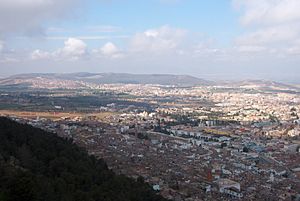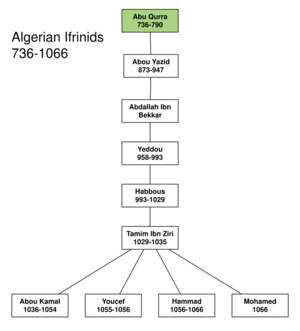Banu Ifran facts for kids
The Banu Ifran (pronounced Bah-noo Ee-frahn) were an important Berber tribe from North Africa. They played a big role in the history of the region before and after Islam arrived. In the 700s, they created their own kingdom in the central part of North Africa, with the city of Tlemcen as its capital.
Before the 700s, the Banu Ifran often fought against foreign groups who tried to take over their land. These included the Romans, Vandals, and Byzantines. In the 600s, they joined forces with Kahina, a famous Berber queen, to resist the Muslim Umayyad armies. Later, in the 700s, they followed the Sufri branch of Islam and started a revolt against the Arab Umayyad and Abbasids rulers.
In the 900s, the Banu Ifran formed a powerful family (a dynasty) that often fought against other groups like the Fatimids, Zirids, Umayyads, Hammadids, and Maghrawa. By the end of the 1000s, the Banu Ifran were defeated by the Almoravids and invading Arab tribes like the Banu Hilal. The Ifranid dynasty was known for defending the local people of the Maghreb, who the Romans called the "Africani." In the 1000s, some Banu Ifran also founded a small kingdom called the Taifa of Ronda in Ronda, Spain, and ruled from Cordoba for many years.
Contents
What Does "Ifran" Mean?
The name of the Berber family, "Ifran," comes from the Berber language. It is the plural form of "ifri" or "afri," which means "cave" or "tunnel."
Some people think the name might come from one of the main gods of the old Berber religion, named Ifru or Ifrou. Another idea is that the name comes from the Yifran region in modern-day northwest Libya, where they might have first lived.
The name "Ifran" has been spelled in many different ways over time, like Ifuraces, Afar, Ifrinidi, or Yefren. But all these names basically mean "The Sons of Ifri." Muslim writers later added the Arabic word "banu-" before the name, which means the same as the Berber word "ayt": "the sons of" or "those of."
History of the Banu Ifran
Early Beginnings
The earliest records about the Banu Ifran show that most of their people lived in the western part of a Roman province called Mauretania Caesariensis. They were one of the four main tribes of the Zenata group, known for their excellent horse riders.
According to a famous historian named Ibn Khaldoun, the "Ifrinides" or "Ait Ifren" successfully fought against the Romans, Vandals, and Byzantines. These groups tried to take control of North Africa before Muslim armies arrived. A writer named Corippus mentioned that between 547 and 550, the Banu Ifran challenged the Byzantine armies to war.
Their leader, Abu Qurra, rebuilt the city of Tlemcen in Algeria in 765. Before that, it was a Roman city called Pomaria. Abu Qurra then set up a kingdom there.
Conflicts in the 900s
In the 900s, the Ifranids became enemies with the Fatimid Caliphate. They joined forces with the Maghrawa tribe and the Umayyad Caliphate of Córdoba in Spain. Even though they sided with the Umayyads, the Banu Ifran themselves followed a different branch of Islam called Kharijites.
One of their leaders, Abu Yazid, led them east and attacked the city of Kairouan in 945. Another leader, Ya'la ibn Muhammad, captured the city of Oran and built a new capital called Ifgan, near Mascara.
However, the Fatimids fought back strongly. Their skilled general, Jawhar, defeated and killed Ya'la in battle in 954. The Fatimids then destroyed Ifgan. For a while, the Banu Ifran became scattered nomads, constantly competing with their neighbors, the Sanhaja tribe. Some Banu Ifran people moved and settled in parts of Spain, like Málaga.
Other Banu Ifran, led by Hammama, managed to take control of the Moroccan province of Tadla. Later, under Abu al-Kamāl, they built a new capital at Salé on the Atlantic coast. This led to conflicts with the Barghawata tribes living along the coast. The Banu Ifran also founded Tadla and Salé, where Tamim ibn Ziri built the Great Mosque of Salé.
Banu Ifran in Morocco
During the 1000s, the Banu Ifran fought with the Maghrawa tribe for control of what is now Morocco, after the Idrisid dynasty fell. Ya'la's son, Yaddū, surprised and captured the city of Fes in January 993. He held it for several months until the Maghrawa ruler, Ziri ibn Atiyya, returned from Spain and took the region back.
In May or June 1033, Ya'la's grandson, Tamīm, recaptured Fes. He was very religious and caused great hardship for the Jewish community in Fes, leading to their persecution and the confiscation of their property. Around 1038–1040, the Maghrawa tribe took Fes back, forcing Tamīm to escape to Salé.
Soon after this, the Almoravids began to rise in power. They eventually conquered both the Banu Ifran and their rivals, the Maghrawa.
Banu Ifran in Spain
The Banu Ifran were also important in al-Andalus (which is present-day Spain) in the 1000s. The Ifran family of Corra ruled the city of Ronda in Andalusia.
Yeddas was a military leader of the Berber troops who fought against the Christian king. Abu Nour of the Corra family became the ruler of Ronda and then Seville in Andalusia from 1023 to 1039, and again from 1039 to 1054. Abu Nour's son, Nour bin Badis Hallal, ruled Ronda from 1054 to 1057, and Abu Nacer ruled from 1057 to 1065.
Beliefs of the Banu Ifran
Before Islam
Before Islam, the Banu Ifran mainly followed a spiritual belief system called animism. In this belief, spirits are thought to live in natural objects and places. Ifri was also the name of a Berber god, and their name might have come from their religious beliefs.
They held special ceremonies, often in caves, to honor Ifru. These rites were meant to gain favor or protection for merchants and traders. The idea of this protection is shown on old Roman coins. Ifru was seen as a sun goddess, a cave goddess, and a protector of the home. She was considered a Berber version of the Roman goddess Vesta.
Dehia, often called The Kahina, was a Berber queen and prophetess. She led the non-Muslim resistance against the advancing Arab armies. Some historians believe Kahina was Christian or Jewish, but few of the Ifran were Christians, even after many centuries of Christianity in cities. Ibn Khaldun simply stated that the Ifran were Berbers and did not mention their religion before Islam.
After Islam Arrived
The Banu Ifran initially opposed the Sunni Muslims of the Arab armies. However, they eventually converted to Islam. After converting, many of them joined the Kharidjite movement, which was a different branch within Islam.
Ibn Khaldun wrote that the "Zenata people say they are Muslims but they still oppose the Arab army." After 711 AD, the Berbers were gradually converted to Islam, and many became very devoted to the faith.
Images for kids
See also
 In Spanish: Beni Ifren para niños
In Spanish: Beni Ifren para niños





